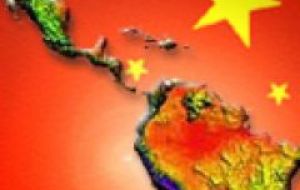MercoPress. South Atlantic News Agency
China rapidly becoming Latinamerica’s main trade and investment partner
 China is the main market for Chilean copper and Argentine soybeans
China is the main market for Chilean copper and Argentine soybeans China is set to become Latinamerica’s second trade partner ahead of the European Union and just behind the United States in the next few years according to a report from the United Nations Economic Commission for Latinamerica and the Caribbean, Cepal.
Based on the evolution of trade and investment from China, the report “China and Latinamerica and the Caribbean: a strategic relation” arrives to the conclusion that the Asian giant will be absorbing 19.3% of Latinamerica’s exports by 2020 compared to 7.6% in 2009.
If this effectively happens as the graphs indicate, the European Union would retain its 14% of Latinamerican trade, but behind China most probably beginning 2015.
The Chinese market advance would be in detriment of the US market which would see its participation of Latinamerican exports fall from 38.6% in 2009 to 28.4% in 2020.
However China’s importance as a market for the region varies very much according to the country. It is essential for countries such as Chile (copper), Peru (strategic minerals, fish meal) and Argentina (soybeans and cereals), but not for Central America with the exception of Costa Rica. Mexican exports to China only represent 1% of its overall trade.
China represents the main market for 13% of Chilean exports; in Peru the percentage is 11, for Argentina 9%, Costa Rica 7% and Brazil, 7%.
As to imports from China a similar situation is anticipated. China could overtake by 2020 both the European Union and United States as the main origin of Latinamerican imports, with a high concentration in capital goods such as electronics, spares, machinery and textiles.
Exports from the region are concentrated in commodities and processed raw materials although at different degrees. Costa Riva, Mexico and El Salvador for example sell to China high technology manufactured goods.
The strong Chinese demand for food, energy, metals and minerals has improved the trade terms for South America helping to spur local growth and development. This strong trade link was vital to explain the region’s resilience during the recent global crisis, indicates Cepal.
However there’s also a warning: the countries of the region must improve the quality of their trade, diversifying exports and increasing added value and technology so at to facilitate their direct insertion in the productive chains of Pacific Asia.
The Cepal reports points out that China has become a strategic trade partner for Latinamerica and the Caribbean with ample opportunities to reach export and investment agreements in different fields such as mining, energy, agriculture, infrastructure and science and technology.
Given the size of the Chinese market and the chances to take advantage of the situation with a concerted or coordinated effort among several countries or regional integration, is highly recommended by Cepal.




Top Comments
Disclaimer & comment rulesCommenting for this story is now closed.
If you have a Facebook account, become a fan and comment on our Facebook Page!